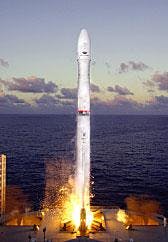It's really rocket science
Sea Launch Co. LLC, based in Long Beach, Calif., has produced perhaps the most creative reuse of a semisubmersible drilling platform. The Sea Launch initiative (www.sea-launch.com) began in April 1995, combining expertise from international aerospace and maritime companies to provide heavy-lift commercial satellite-launch services from an equatorial, Pacific Ocean-based platform. Launching from the equator eliminates the need for plane-change maneuvers.
After receiving its first contract, the multinational partnership began constructing the 660 ft long (110 ft beam) assembly-and-command ship (ACS) in December 1995. The ACS was launched from Kvaerner AS's Govan shipyard in Glasgow, December 1996, as the Sea Launch Commander. It serves as a floating rocket assembly factory while in port, provides crew and customer accommodations, and houses mission control facilities for launches at sea.
The self-propelled semi chosen for the launch platform was formerly active in North Sea drilling and was refurbished at the Rosenberg shipyard in Stavanger. It's 436 ft long and about 220 ft wide, with an empty draft displacement of 30,100 tons and a submerged draft displacement of 50,600 tons. It sailed from Norway to Russia in May 1997, and modifications were finished in May 1998. Both vessels arrived in southern California in second half 1998.
Sea Launch uses a three-stage Zenit-3SL rocket to send satellites into a high-perigee, geosynchronous-transfer orbit. The 200 ft long rockets are built by Boeing Satellite Systems in El Segundo, Calif., and have the capacity to carry a payload up to 13,227 lb into geosynchronus-transfer orbit.
The payload is carried in the uppermost 37.4 ft. The Galaxy XIII/Horizons-1 satellite, launched on Sept. 30, weighed 9,081 lb (see photo).
null
The inaugural launch, on Mar. 27, 1999, carried a test payload, simulating a 9,900 lb commercial spacecraft.
The first commercial mission was the successful launch of the 7,600 lb DirecTV 1-R broadcast satellite on Oct. 9, 1999.
There have been 10 successful launches to date; 3 of the 4 scheduled for 2003 have already launched, with 15 launches waiting. The heaviest payload to date was the 11,260 lb Thuraya-1 mobile communications satellite, launched on Oct. 20, 2000.
Logistics
The Odyssey launch platform and its sister ship, the Sea Launch Commander, sail from their berths in the Port of Long Beach, Calif., to an equatorial launch site at 154° west longitude.
After arriving on location, both vessels use dynamic positioning systems—designed by Kongsberg Simrad, part of Kongsberg Maritime, the civilian division of Norwegian Kongsberg Gruppen ASA—to remain stationed alongside each other, bridge-linked to allow foot traffic between them.
The crew ballasts the semi to launch depth, 65-70 ft, and orients the platform to minimize wind and wave effects.
They transfer the rocket from an environmentally protected hangar and erect it on the launch pad.
On the day of the launch, the platform is evacuated, and all personnel remain on the ship, 3 miles away, throughout launch operations. Sea Launch provides live satellite broadcasts and simultaneous webcasts of each launch.
Sea Launch partners are Boeing Commercial Space Co., Kent, Wash. (provides spacecraft integration, payload fairings, and project management); Kvaerner, Oslo (built the Sea Launch vessels); RSC Energia, Moscow (provides the upper stage and its integration with the launch vehicle); and SDO Yuzhnoye/PO Yuzhmash of Dnepropetrovsk, Ukraine (provides the first two stages of the launch vehicle).
On Oct. 20, Sea Launch announced a new venture, Land Launch, which plans to offer launch services from the Baikonur Cosmodrome in Kazakhstan, in addition to its sea-based launches at the Equator. Land Launch is a collaboration of Sea Launch & Space International Services (SIS), Russia, focused on launching medium-weight satellites (4,400-7,700 lb).

